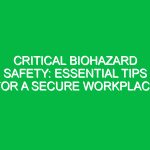Welcome team,
Today, we are gathered to discuss a crucial topic that affects our health, safety, and overall well-being in the workplace: the dangers of excessive sitting. In our daily operations, we often find ourselves seated for extended periods, which can pose significant risks to our health if not managed properly. By understanding the hazards associated with excessive sitting and implementing preventive measures, we can create a safer and healthier work environment for all. Let’s delve into the details of this important issue.
The Impact of Excessive Sitting on Health, Safety, and Environment
Excessive sitting has been linked to a myriad of health problems, including musculoskeletal disorders, cardiovascular issues, obesity, and reduced productivity. When we spend prolonged hours in a seated position, our bodies experience strain on the muscles, joints, and circulation system. This not only affects our physical health but also impacts our mental well-being and job performance.
Recognizing the Signs and Symptoms
It’s essential to be aware of the signs and symptoms that indicate the negative effects of excessive sitting. These may include back pain, neck stiffness, fatigue, decreased flexibility, and poor posture. By recognizing these indicators early on, we can take proactive steps to prevent further harm to our bodies.
Potential Hazards and Risks
Excessive sitting can lead to an increased risk of developing chronic conditions such as obesity, diabetes, and cardiovascular diseases. Additionally, prolonged sitting without proper ergonomic support can result in musculoskeletal injuries and repetitive strain injuries. It is imperative to address these risks to maintain a safe and healthy workplace environment.
Best Practices for Combating the Risks
To mitigate the dangers of excessive sitting, we can incorporate the following best practices into our daily routine:
- Regular Movement: Take short breaks every hour to stretch, walk around, or change positions.
- Ergonomic Setup: Ensure your workstation is ergonomically designed to support good posture and reduce strain on your body.
- Exercise Regimen: Incorporate physical activity into your daily schedule to counteract the effects of prolonged sitting.
- Hydration and Nutrition: Stay hydrated and maintain a balanced diet to promote overall health and well-being.
Regulations and Compliance
As part of our commitment to health, safety, and environment (HSE), it is essential to adhere to relevant regulations and company policies regarding ergonomic practices, workstation setup, and employee well-being. By complying with these standards, we not only protect ourselves but also contribute to a safer work environment for everyone.
Conclusion
As we conclude this toolbox talk on the dangers of excessive sitting, I urge each one of you to prioritize your health and well-being while performing your duties. By implementing the best practices discussed today and remaining vigilant about the risks associated with prolonged sitting, we can create a culture of safety and wellness within our workplace. Thank you for your attention and dedication to maintaining a safe working environment.


